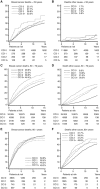Influence of comorbidity on the effect of adjuvant treatment and age in patients with early-stage breast cancer
- PMID: 23079577
- PMCID: PMC3504938
- DOI: 10.1038/bjc.2012.472
Influence of comorbidity on the effect of adjuvant treatment and age in patients with early-stage breast cancer
Abstract
Background: Prevalence of comorbidity at breast cancer diagnosis increases with age and is likely to influence the likelihood of receiving treatment according to guidelines. The aim of this study was to examine the effect of breast cancer treatment on mortality, taking age at diagnosis and comorbidity into account.
Methods: Four nationwide population registries in Denmark: the Danish Civil Registration System, the Danish Breast Cancer Cooperative Group, the Danish National Patient Register, and the Danish Register of Causes of Death provided information on 62 591 women diagnosed with early-stage breast cancer, 1990-2008, of whom data on treatment were available for 39 943. Comorbidity was measured using the Charlson Comorbidity Index. Adjuvant treatment were categorised as none, chemotherapy, endocrine therapy, and unknown. Multivariable Cox modelling assessed the effect of comorbidity on breast cancer-specific mortality and other cause mortality according to treatment, adjusting for age at diagnosis and other clinical prognostic factors.
Results: The impact of comorbidity on mortality was most pronounced in patients aged 50-79 years. Patients receiving chemotherapy with mild to moderate comorbidity had HR 0.99 (95% confidence interval (CI); 0.82-1.19) and 1.06 (95% CI; 0.77-1.46) for breast cancer-specific mortality, respectively, compared with patients without comorbidity.
Conclusion: Comorbidity at breast cancer diagnosis is an independent adverse prognostic factor for death after breast cancer. We identified a subgroup of patients with mild to moderate comorbidity receiving chemotherapy who had similar breast cancer mortality as patients with no comorbidity.
Figures





References
-
- Alistair R (2010) The influences of age and co-morbidities on treatment decisions for patients with HER2-positive early breast cancer. Crit Rev Oncol/Hematol 76(2): 127–132 - PubMed
-
- Alpérovitch A, Bertrand M, Jougla E, JSb Vidal, Ducimetière P, Helmer C, Ritchie K, Pavillon G, Tzourio C (2009) Do we really know the cause of death of the very old? Comparison between official mortality statistics and cohort study classification. Eur J Epidemiol 24(11): 669–675 - PubMed
-
- Bouchardy C, Rapiti E, Blagojevic S, Vlastos AT, Vlastos G (2007) Older female cancer patients: importance, causes, and consequences of undertreatment. J Clin Oncol 25(14): 1858–1869 - PubMed
-
- Carlsen K, Høybye MT, Dalton SO, Tjønneland A (2008) Social inequality and incidence of and survival from breast cancer in a population-based study in Denmark, 1994-2003. Eur J Cancer 44(14): 1996–2002 - PubMed
-
- Charlson ME, Pompei P, Ales KL, MacKenzie CR (1987) A new method of classifying prognostic comorbidity in longitudinal studies: development and validation. J Chronic Dis 40(5): 373–383 - PubMed
Publication types
MeSH terms
LinkOut - more resources
Full Text Sources
Medical

